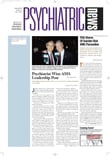A new, nationally representative survey estimates that depression costs U.S. employers more than any other illness in terms of the lost productivity of their employees. According to results of the Depressive Disorders Study, (DDS) completed one year ago, workers with depression cost employers more than three times the amount associated with lost productivity from all other illness.
Results from the DDS, a subsurvey of the American Productivity Audit, were published in the June 18
Journal of the American Medical Association, a theme issue featuring eight articles on depression (see
story on facing page).
The American Productivity Audit surveyed more than 30,000 employed individuals last summer to estimate the impact of various illnesses on labor costs, including work absences and reduced productivity on the job, in the U.S. workforce. The DDS and its related estimates are based on a nationally representative subsample of 3,351 of the larger group interviews.
“You cannot manage costs to employers without first measuring the impact of various illnesses,” said Walter Stewart, Ph.D., M.P.H., a researcher with AdvancePCS Center for Work and Health in Hunt Valley, Md., at the time the survey was conducted. Stewart is now at the Outcomes Research Institute of Geisinger Health Systems in Danville, Pa. AdvancePCS conducted the American Productivity Audit and provided funding for the study, while Eli Lilly and Company provided funding for the DDS analysis.
Stewart added, “We know that employers won’t act on what they cannot measure.” Unfortunately, he continued, “employers focus much more on how much they are paying for employee health care rather than on steps to make the health care plan more cost-effective.”
DDS was necessary, Stewart emphasized, because previous estimates of the cost of depression in the U.S. workplace were based on data collected during the 1980s and included assumptions regarding prevalence, duration of depressive episodes, impact on work, and associated labor costs. Stewart wanted to fill in the real-world numbers to come up with a sound estimate of actual costs.
The overall data from the larger audit are based on the “Work and Health Interview,” a five- to 15-minute telephone interview that includes questions in reference to only the previous two-week period and asks about occupation, a self-reported health assessment, the number of days of work missed in the previous two weeks, and how that affected the respondent’s productivity on the job. Also, questions elicited information on income, quality of life, and any treatments obtained, as well as standard demographic details.
The DDS subset was composed of 733 individuals who completed the interview and screened positive for possible depression, along with 457 gender-matched individuals who screened negative for depression. During a follow-up interview, those individuals were then administered the PRIME-MD mood module and the Somatic Symptom Inventory and asked further questions regarding treatment.
Stewart reported at a JAMA press briefing in Washington, D.C., last month that 9.4 percent of the total sample was found to have a depressive disorder, with 3.4 percent meeting screening criteria for major depression, 2.4 percent for partial remission of major depression, and 3.6 percent for dysthymia. Depressive symptoms were more common in women and people with lower levels of education.
Twenty percent of the $44 billion cost of depression was accounted for by absenteeism, while 80 percent of the costs associated with depression, or $35.7 billion, was linked to “presenteeism”—that is, present on the job but with significantly reduced productivity.
This, Stewart noted, is a major finding that should be reinforced over and over with employers. They believe the employees are generally fine because the employees are on the job, Stewart noted; however, they do not realize the “hidden costs” of lost productivity due to lack of energy, lack of insight, lack of creativity or motivation—all items difficult to quantify. Those interviewed estimated that with depression, they lost an average of 5.6 hours a week of productivity, versus 1.5 hours a week for persons without depression.
In terms of treatment, the DDS found that about 25 percent of individuals with depression had received treatment and of those, the patients said that on a scale of treatment effectiveness self-reported by the subjects, from zero (doesn’t work at all) to 10 (complete relief), the average rating was midline, at 5.6.
“Major depression may not be the most common illness, but is it probably the most costly,” Stewart concluded. “And these numbers do not include short- and long-term disability. Most of these costs are invisible, but the average loss of 14 percent in productivity time is concentrated in a minority of workers who are depressed.”
Major depression is an important target for employers and their health care plans, Stewart noted, because “it accounts for 50 percent of work-related costs, but may not be effectively and appropriately identified and treated. We need to improve that.”
JAMA 2003 289 3135

